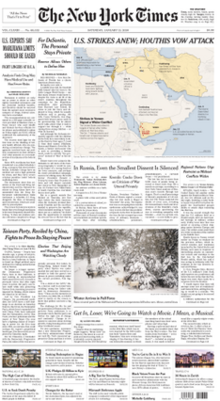Our News Articles PDFs
Our News Articles PDFs
Blog Article
The Only Guide for News Articles
Table of ContentsNews Articles Things To Know Before You Get ThisExcitement About News ArticlesThe Best Guide To News ArticlesThe 3-Minute Rule for News ArticlesExcitement About News Articles
Excellent knowledge of different subjects provides students a competitive edge over their peers. Also though electronic and social media are conveniently accessible, we need to not forget just how essential it is to review the papers. Parents need to attempt and instill the routine of checking out a newspaper as an everyday routine to proceed the tradition of the revered print tool.News stories likewise include at the very least one of the adhering to vital characteristics loved one to the desired audience: closeness, prestige, timeliness, human interest, strangeness, or effect.
Within these limitations, information stories also intend to be extensive. Among the larger and much more reputable papers, fairness and equilibrium is a significant element in providing information.
Papers with a global target market, for instance, tend to make use of a much more formal design of writing. The certain selections made by a news outlet's editor or content board are often accumulated in a style guide; typical style guides include the and the US Information Style Book. The main objectives of information writing can be summed up by the ABCs of journalism: accuracy, brevity, and quality.
What Does News Articles Do?
As a rule, journalists will not utilize a long word when a short one will certainly do. They use subject-verb-object building and vibrant, active prose (see Grammar). They use narratives, instances and metaphors, and they hardly ever depend upon generalizations or abstract ideas. Information writers attempt to stay clear of using the exact same word more than once in a paragraph (occasionally called an "echo" or "word mirror").
However, headings often omit the subject (e.g., "Jumps From Watercraft, Catches in Wheel") or verb (e.g., "Cat woman lucky"). A subhead (likewise subhed, sub-headline, subheading, caption, deck or dek) can be either a subordinate title under the major heading, or the heading of a subsection of the write-up. It is a heading that comes before the primary text, or a team of paragraphs of the primary text.

Additional billboards of any of these kinds may appear later on in the write-up (especially on succeeding web pages) to attract further analysis. Such billboards are likewise utilized as guidelines to the article in various other areas of the publication or site, or as ads for the piece in various other magazine or websites. Typical framework with title, lead paragraph (recap in strong), other paragraphs (details) and get in touch with information.

Instance of a hard-lead paragraph NASA is recommending an additional room job. The budget plan requests about $10 billion for click to read the task.
An "off-lead" is the 2nd most essential front page information of the day. To "bury the lead" is to start the write-up with history information or details of secondary value to the viewers, forcing them to review even more deeply right into a short article than they should have to in order to find the essential points.
The Main Principles Of News Articles
Usual use is that or 2 sentences each develop their own paragraph. Reporters normally explain the organization or framework of a newspaper article as an inverted pyramid. The crucial and most intriguing elements of a tale are put at the start, with supporting details complying with in order of reducing relevance.
It enables individuals to check out a subject to only the depth that their inquisitiveness takes them, and without the imposition of details or subtleties that they can take into consideration unnecessary, but still making that information offered to more interested readers. The inverted pyramid structure also makes it possible for articles to be trimmed to any type of approximate size throughout layout, to fit in the space readily available.
Some writers begin their tales with the "1-2-3 lead", yet there are several kinds of lead readily available. A kicker can refer to several things: The last tale in the information broadcast; a "pleased" tale to finish the program.
Longer articles, such as magazine cover articles and the pieces that lead the inside sections of a paper, are called. Feature stories differ from straight information in numerous ways. Foremost is the absence of a straight-news lead, a lot of the time. Instead of using the significance of a tale in advance, attribute writers may attempt to lure viewers in.
News Articles Things To Know Before You Buy
The journalist often browse around these guys information communications with meeting subjects, making the item more personal. A feature's initial paragraphs usually associate an intriguing moment or event, as in an "anecdotal lead". From the particulars of an individual or episode, its view rapidly expands to abstract principles about the story's topic. The section that indicates what a recommended you read feature has to do with is called the or signboard.

The Editor's Toolbox: A Reference Overview for Beginners and Professionals (2001) Allan M. Siegal and William G. Connolly. The New York City Times Guidebook of Design and Usage: The Authorities Design Guide Utilized by the Writers and Editors of the Globe's Many Authoritative Newspaper (2002) M. L. Stein, Susan Paterno, and R.
Report this page